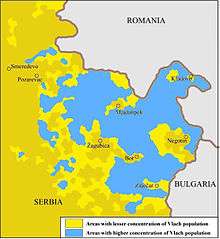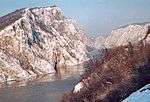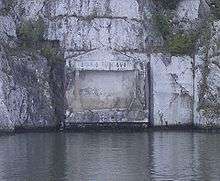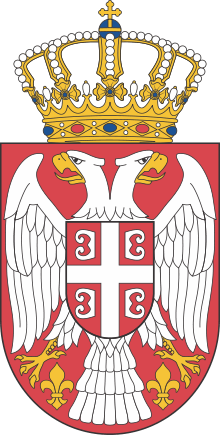Timočka Krajina
.jpg)
Timočka Krajina (Serbian Cyrillic:Тимочка Крајина) is a geographical region in east-central Serbia around the Timok River. Its name means "Timok frontier". Timočka Krajina corresponds to two Serbian districts (Bor and Zaječar), with a total 2002 census population of 284,112.
Name
Timok derives its name from the ancient district of Timachiom from Roman times. Its name means "the Timacus frontier". The region was named due to its location around the Timacus or Timok River and near the state border (hence the name "krajina" - "frontier" in English). In Serbian, the region is known as Timočka Krajina (Тимочка Крајина), in Romanian Valea Timocului (Timoc Valley). In Bulgarian it is known as Timoshko (Тимошко).
Geography
Timočka Krajina roughly corresponds to the Bor and Zaječar districts of Serbia. It includes seven municipalities and one city:
- Zaječar - 66,000
- Bor - 48,000
- Negotin - 43,000
- Knjaževac - 37,000
- Sokobanja - 19,000
- Kladovo - 21,000
- Boljevac - 15,000
- Majdanpek - 23,000
The largest city in the region is Zaječar, and therefore functions as its cultural, urban, and economic centre. It consists of four municipalities: Stari grad (old parts of the city: Vlačić, Kraljevica, Karađorđev venac, Šljivarsko brdo, Lubničko brdo, Oskoruša, Pazaršte, Zvezdan, Podliv, Veliki izvor), Kotlujevac (Ključ 1,2,3,4, Živinarnik, Selište, Vlaško brdo, Beli breg), Grljan (south suburban parts and Višnjar) and Salaš (north suburban parts). The largest ethnic group in Zaječar is Koltlujevac, with a population of over 25,000.
History
Early Bronze Age pottery of the Kostolac-Kocofeni culture has been found in Veljko, Štubik, Zlotske caves.[1]
Descendants of Tribalia, Dacians and Thracians were Romanised after the Roman conquest. They continued in the area until contemporary times, when ethnical assimilation (see Serbisation) has sought to subdue the large Romanian groups in the area. The Romans conquered Timok in the 1st century; Emperor Justinian had these strongholds in the region:
|
Petres Sculcoburgo Vindimiola Braeola Arganocili Castellonovo Florentiana Romyliana (Romuliana, in Romanian) Septecasae (Septe case, in Romanian) Argentares (Argintari, in Romanian) Auriliana (Aureliana, in Romanian) Gembero Clemades Turribas Gribo Chalaro Tzutrato Mutzipara in (Muţipara, in Romanian) Stendas Scaripara Odriuzo Cipipene Trasiana Potes Amulo Setlotes Timaciolum Meridio Meriopontede Tredetetilious Braeola Motreses Vicanovo Quartiana Julioballae Pontzas Zanes |
Triballian Plains, Tribalia or Lower Timok is the southern territory of the Timočka Krajina, between the Yantra and Morava rivers. Its name is derived from the Paleo-Balkan tribe of Triballi who lived in the region. In the 11th century, Greek-Byzantine historian John Skylitzes referred to the region as "ton topon ton Serbon" (eng. Serb region).
Between 1918 and 1922, two districts of the Kingdom of Serbs, Croats and Slovenes existed in the area - Krajina District, with seat in Negotin, and Timok District with seat in Zaječar. In 1922, these two districts were merged into the newly formed Timok Oblast with seat in Zaječar. Timok Oblast existed until 1929 when it was included into the newly formed Morava Banovina with seat in Niš. At present there are two districts in the area: Bor District with seat in Bor; and Zaječar District with seat in Zaječar.
In 2005, the Parliamentary Assembly of the Council of Europe "regretted that Serbia applies double standards in artificially separating the Romanians of Vojvodina from the Romanians of Eastern Serbia".[2] Since 2004 there are regular clashes between the Serbian authorities and the Romanian community in Timok when Bojan Aleksandrović, a Romanian Orthodox priest decided to build the Romanian Orthodox Church, Malajnica where he holds services in Romanian. The priest has been subjected to threats while children attending mass with their parents have been humiliated in the village school by their Serbian teacher. Romanians in Serbia proper do not have the right to schooling and public worship in their native language. In Negotin, the Romanian Cultural Association was vandalized in 2004 when Serbian pro-fascist ultra-nationalists wrote "Out of Serbia" on the windows of the main doors.[3][4] The Helsinki Committee for Human Rights in Serbia drew attention to the situation of the Romanian people living in Timok, and to their right to preserve their Romanian identity.[5][6]
Until January 2012, Serbia had adamantly refused to approve opening of the Romanian Consulate General in Timok in which an important Romanian community lives.[7][8][9][10])
Demographics


According to the 2002 census, the Bor and Zaječar Districts had a total of 284,112 inhabitants, out of which:
In the north, the inhabitants traditionally speak the Kosovo–Resava dialect, while in the south, the Prizren-Timok dialect is spoken (also considered part of the Torlakian dialect), however, Standard Serbian (Shtokavian) is used in formal communication. The Vlachs speak the Vlach language, which awaits standardization, which in this region is a form of the Oltenian subdialect.[11]
The Serb (and Vlach) population is Serbian Orthodox and the Romanian population is Romanian Orthodox.[12] Built in 2004, the Romanian Orthodox Church, Malajnica is the first Romanian church in Timočka Krajina in 170 years, during which time Romanians in Timok had not been allowed to hear liturgy services in their native language.[13][14][15]
Economy
The region is rich in copper and gold mines, especially in the Bor and Majdanpek areas.
Gallery
 The Kazan gorge
The Kazan gorge
- Panoramic view of Sokobanja
.jpg) Timok in 1740
Timok in 1740 Folkloric group from Jabukovac
Folkloric group from Jabukovac- Romanians from Ždrelo in 1868
See also
References
- ↑ http://www.rastko.rs/arheologija/srejovic/dsrejovic-eneolit.html
- ↑ Respect for the rights of the Timok Romanians (Eastern Serbia)
- ↑ Protests on the Council of Europe
- ↑ April 25, 2003] on Deutsche Welle
- ↑ Extract from the IHF report
- ↑ Debates Monday, 3 September 2007 - Strasbourg
- ↑ Timoc Press, General Consulate of Romania in Zajecar
- ↑ Romania, Serbia decide to establish small-scale cross-border traffic agreement
- ↑ Meeting of Foreign Minister Cristian Diaconescu with Serbian counterpart Vuk Jeremić
- ↑
- ↑ http://www.romanialibera.ro/a103742/romanii-din-valea-timocului-recunoscuti-drept-minoritate-nationala.html
- ↑ http://www.ziuadevest.ro/actualitate/5863-biserica-roman-din-timoc-a-fost-recunoscut-de-ctre-curtea-suprem-de-justiie-a-serbiei.html
- ↑ Xenophobic actions against Timoc Romanians
- ↑ "SERBIA: Romanian priest to pay for official destruction of his church"
- ↑ "Haiducul credintei din Valea Timocului, Boian Alexandrovici, decorat de presedintele Basescu" (Romanian)
External links
| Wikimedia Commons has media related to Timočka Krajina. |
- INFO centar Timočke krajine
- History of the Romanians-Vlachs of Serbia
- Maps of Vlachs in north-east Serbia
- Community of Vlachs of Serbia/Zajednica Vlaha Srbije
- The situation of national minorities in Vojvodina and of the Romanian ethnic minority in Serbia, 2008 report from the Council of Europe (archive version)
Coordinates: 44°00′N 22°10′E / 44.000°N 22.167°E
